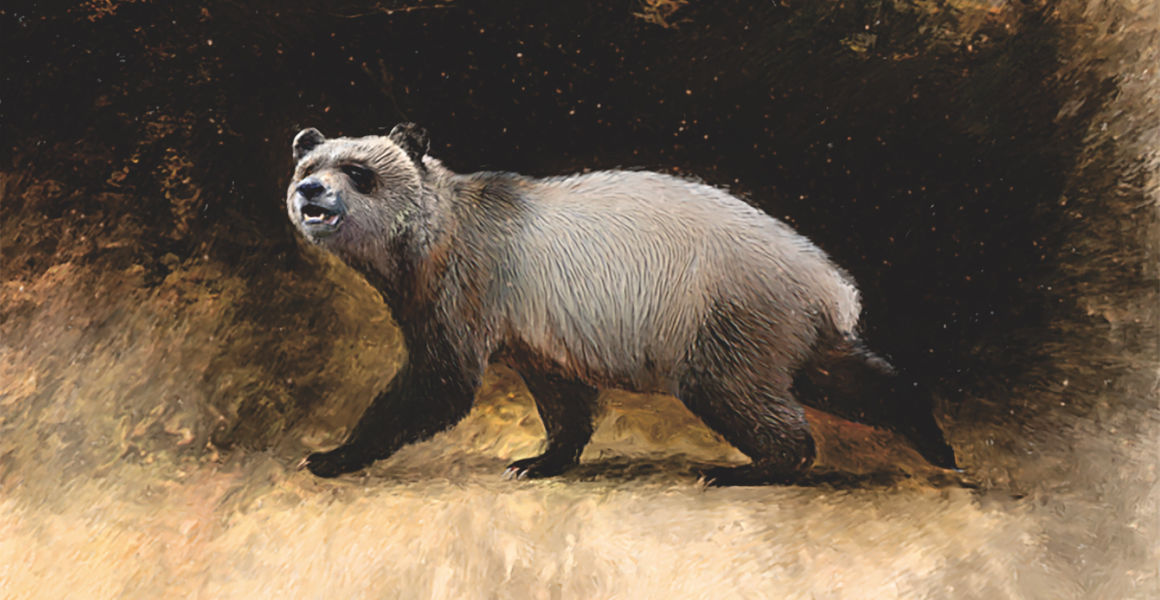An ancient European panda has been described from a pair of fossil teeth discovered in Bulgaria.
While the evolutionary history of the bears remains uncertain, it contributes evidence to suggestions that panda bears could have evolved in Europe.

The ancient panda Agriarctos nikolovi is believed to have been a similar size to its modern descendants. Image © Velizar Simeonovski, Chicago
An ancient European panda has been described from a pair of fossil teeth discovered in Bulgaria.
While the evolutionary history of the bears remains uncertain, it contributes evidence to suggestions that panda bears could have evolved in Europe.
An ancient species of European panda may have been one of the last of its kind to roam the continent.
Discovered in Bulgaria, Agriarctos nikolovi was described from two fossil teeth unearthed in the western part of the Sredna Gora mountain range in the 1970s. It is believed to have lived around six million years ago and is believed to have measured up to two metres long – around the same as giant pandas alive today.
Professor Nikolai Spassov, who co-authored a description of the species, says, 'Although not a direct ancestor of the modern genus of the giant panda, it is its close relative.'
'This discovery shows how little we still know about ancient nature and demonstrates that historic palaeontological finds can lead to unexpected results, even today.'
While the researchers believe there is sufficient evidence to name a new species, there is a great deal of uncertainty surrounding the evolution and relationships between ancient pandas, especially in Europe. The status of A. nikolovi, along with its relatives, is likely to change further as more fossils are uncovered.
The description of the species was published in the Journal of Vertebrate Palaeontology.

While modern pandas are almost entirely dependent on bamboo, Agriarctos nikolovi is thought to have eaten softer plants. Image © Grace800/Shutterstock
The evolution of pandas has long been a contentious subject for scientists, with disagreements over exactly where the species should be placed in the tree of life. Initially, similarities between the giant panda and the red panda, such as their tooth structure and skull shape, had been used to argue that they were both raccoons, rather than bears.
This was settled in the 1980s, when genetic analysis revealed that the ancestor of the red panda had in fact split off from the ancestors of bears between 30 and 50 million years ago. The ancestors of the giant panda evolved around 10 million years later, making them the oldest bear lineage.
However, how exactly today's giant pandas evolved still remains something of a mystery. Many of the bears' ancestors are identified only by their teeth or parts of their jaw, which makes it difficult for scientists to accurately assign these fossils to a species.
While today the bears are only found in China, the earliest potential member of the giant panda's group, the Ailuropodini, is found elsewhere. Unearthed in Spain, Kretzoiarctos beatrix is estimated to be around 12 million years old.
However, other scientists think that K. beatrix is not a true panda and represents a different lineage of closely related bears.
If K. beatrix is the earliest ancestor of the giant panda, then it could mean that the bears evolved in Europe before dispersing into Asia. Alternatively, the Ailuropodini could have evolved in Asia before spreading to China and into Europe.
In any event, A. nikolovi was a later member of the group, and is around half the geological age of K. beatrix. If pandas did originate in Europe, there's a strong possibility that A. nikolovi may have been the last of them.

The fossils of Agriarctos nikolovi were found in the Sredna Gora mountains. Image © stoyanh/Shutterstock
After a canine and a carnassial tooth of an unknown animal were found in Bulgarian coal deposits, they were given to the Bulgarian National Museum of Natural History.
On arrival, they were categorised by the museum's former palaeontologist, Dr Ivan Nikolov, who deposited them in the collections. Many years later, Nikolai would name the new species after his former colleague after working out the origin and identity of the teeth.
'They had only one label written vaguely by hand,' the professor recalls. 'It took me many years to figure out what the locality was and what its age was. Then it also took me a long time to realise that this was an unknown fossil giant panda.'
The researchers believe it is a panda based on the shape and size of the teeth when compared to other living and extinct species. However, it has larger and more complex ridges and lobes than its relatives, leading the researchers to describe it as a new species.
Based on the size of the teeth, it is believed that A. nikolovi would have been around the same size as a modern giant panda, but with a softer diet than the bamboo that these animals enjoy today.
The bear would have lived in ancient humid forests and swamps, which were uncommon in the Balkans at the time. Here, the scientists speculate that it may have used its large canines to defend itself from other animals which lived in the area, including sabre-toothed cats.
However, the species was unable to defend itself against the loss of its ancient habitat, as the swamps rapidly dried up when the Strait of Gibraltar became sealed around 5.9 million years ago, cutting off the Mediterranean from the Atlantic.
As the sea dried during this event, known as the Messinian salinity crisis, the ancient panda would have struggled to find the plants it depended on. Even though the Mediterranean was eventually reconnected to the Atlantic Ocean 5.3 million years ago, it came too late for A. nikolovi.
'Giant pandas are a very specialised group of bears,' Nikolai explains. 'Even if A. nikolovi was not as great a habitat and food specialist as the modern giant panda, fossil pandas were specialised enough and their evolution was related to humid, wooded habitats.'
'It is likely that climate change at the end of the Miocene in southern Europe, leading to aridification, had an adverse effect on the existence of the last European panda.'

We're working towards a future where both people and the planet thrive.
Hear from scientists studying human impact and change in the natural world.
Don't miss a thing
Receive email updates about our news, science, exhibitions, events, products, services and fundraising activities. We may occasionally include third-party content from our corporate partners and other museums. We will not share your personal details with these third parties. You must be over the age of 13. Privacy notice.
Follow us on social media